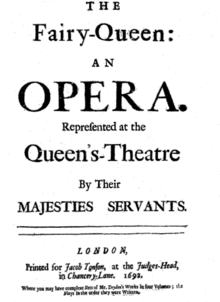The Fairy-Queen
| The Fairy-Queen | |
|---|---|
| Opera by Henry Purcell | |

Title page of the original printed edition
|
|
| Description | Restoration spectacular |
| Based on |
A Midsummer Night's Dream by William Shakespeare |
| Premiere | 2 May 1692 Queen's Theatre, Dorset Garden, London |
The Fairy-Queen (1692; Purcell catalogue number Z.629) is a masque or semi-opera by Henry Purcell; a "Restoration spectacular". The libretto is an anonymous adaptation of William Shakespeare's wedding comedy A Midsummer Night's Dream. First performed in 1692, The Fairy-Queen was composed three years before Purcell's death at the age of 35. Following his death, the score was lost and only rediscovered early in the twentieth century.
Purcell did not set any of Shakespeare's text to music; instead he composed music for short masques in every act but the first. The play itself was also slightly modernised in keeping with seventeenth-century dramatic conventions, but in the main the spoken text is as Shakespeare wrote it. The masques are related to the play metaphorically, rather than literally. Many critics have stated erroneously that they bear no relationship to the play, but recent scholarship has shown that the opera, which ends with a masque featuring Hymen, the God of Marriage, was actually composed for the fifteenth wedding anniversary of William and Mary.
Growing interest in Baroque music and the rise of the countertenor contributed to the work's re-entry into the repertoire. The opera received several full-length recordings in the latter part of the 20th century and several of its arias, including "The Plaint" ("O let me weep"), have become popular recital pieces.
In July 2009, in celebration of the 350th anniversary of Purcell's birth, The Fairy-Queen was performed by Glyndebourne Festival Opera using a new edition of the score, prepared for the Purcell Society by Bruce Wood and Andrew Pinnock.
The Fairy-Queen was first performed on 2 May 1692 at the Queen's Theatre, Dorset Garden in London by the United Company. The author or at least co-author of the libretto was presumably Thomas Betterton, the manager of Dorset Garden Theatre, with whom Purcell worked regularly. This belief is based on an analysis of Betterton's stage directions. A collaboration between several playwrights is also feasible. Choreography for the various dances was provided by Josias Priest, who also worked on Dioclesian and King Arthur, and who was associated with Dido and Aeneas.
...
Wikipedia
